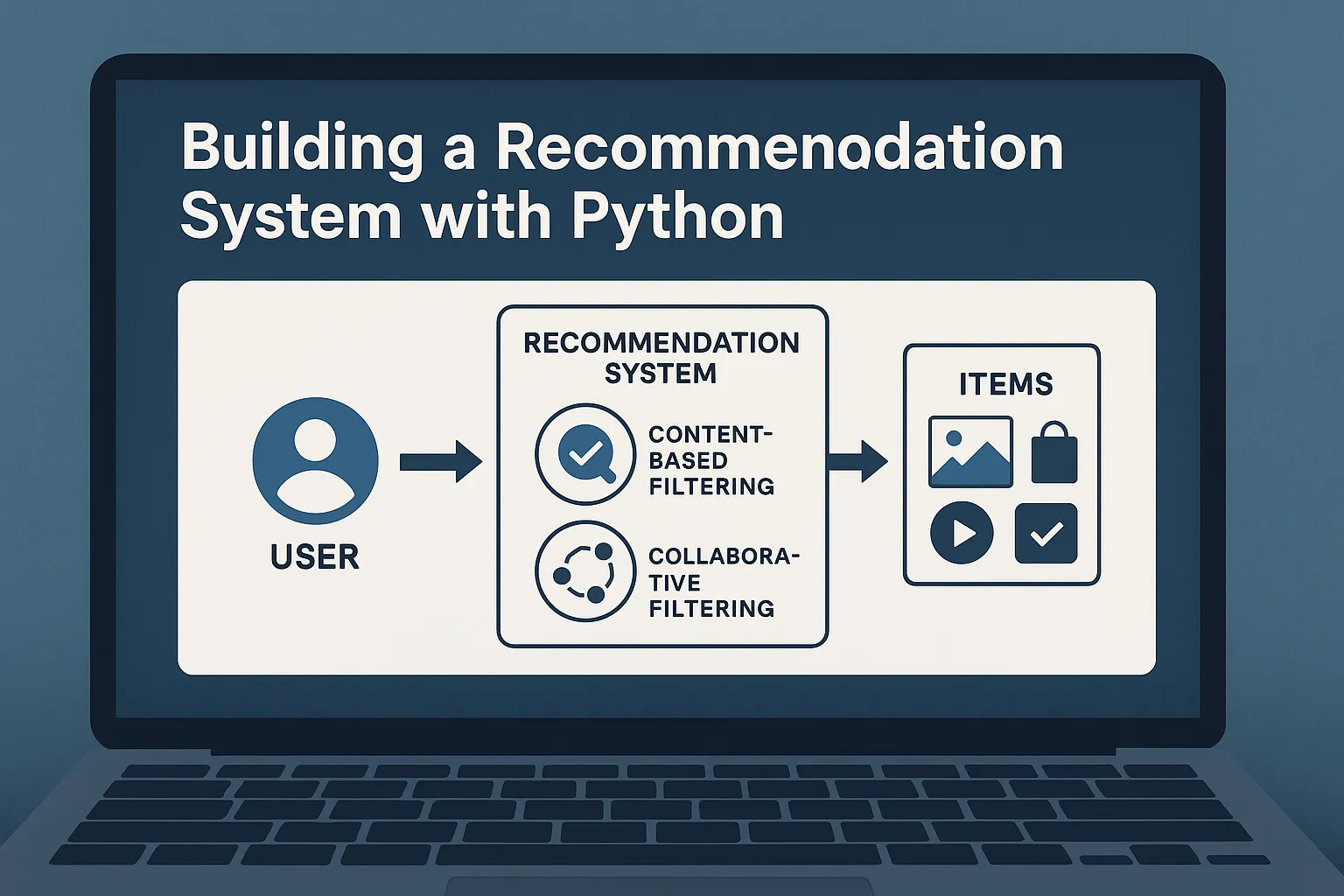
Recommendation systems are everywhere — they decide what we watch, what we buy, and even what we read next. Whether it’s Netflix recommending your next show or Amazon suggesting a related product, these systems are built to understand user behavior and personalize the experience. In this guide, we’ll explore the foundations of recommendation engines and walk step-by-step through building one in Python using two common techniques: content-based filtering and collaborative filtering.
What Is a Recommendation System?
A recommendation system predicts a user’s interests based on available data — such as previous ratings, browsing history, or preferences — and suggests the most relevant items. It’s one of the most practical and commercially valuable applications of machine learning, powering engagement and retention for modern digital platforms.
Types of Recommendation Systems
While every company fine-tunes their own variant, nearly all recommendation systems fall into one of three categories:
- Content-Based Filtering: Recommends items similar to what a user already liked by comparing item features (e.g., movie genres, descriptions, keywords).
- Collaborative Filtering: Finds patterns between users — if two users share similar preferences, one user’s favorites may be recommended to the other.
- Hybrid Models: Combine both approaches to increase accuracy and overcome their individual limitations.
Setting Up the Environment
To get started, you’ll need a few standard Python libraries for data handling and machine learning. Install them with:
pip install pandas numpy scikit-learnMethod 1: Content-Based Filtering
This method recommends items based on their characteristics. If two items are similar in their content — such as genre, description, or keywords — the model assumes a user who liked one will like the other. Let’s walk through an example using movies.
Step 1: Load the Dataset
import pandas as pd
from sklearn.feature_extraction.text import TfidfVectorizer
from sklearn.metrics.pairwise import cosine_similarity
# Sample dataset
data = pd.DataFrame({
'Movie': ['Inception', 'Interstellar', 'The Dark Knight', 'Tenet'],
'Genre': ['Sci-Fi Action', 'Sci-Fi Drama', 'Action Crime', 'Sci-Fi Thriller']
})
Step 2: Convert Text to Numerical Data
We use the TF-IDF (Term Frequency–Inverse Document Frequency) technique to convert movie genres into a numerical matrix. This allows us to calculate similarity between movies using cosine similarity.
vectorizer = TfidfVectorizer()
genre_matrix = vectorizer.fit_transform(data['Genre'])
similarity = cosine_similarity(genre_matrix)
Step 3: Recommend Similar Movies
def recommend_movie(movie_name):
idx = data[data['Movie'] == movie_name].index[0]
scores = list(enumerate(similarity[idx]))
scores = sorted(scores, key=lambda x: x[1], reverse=True)[1:3]
return [data.iloc[i[0]]['Movie'] for i in scores]
print(recommend_movie('Inception'))
This returns movies that are most similar to the one provided — a simple yet powerful demonstration of how content-based recommendations work.
Method 2: Collaborative Filtering
Unlike content-based filtering, collaborative filtering doesn’t rely on item features. Instead, it analyzes user behavior to find similarities between users or items. If User A and User B liked the same movies, the system can recommend User B’s favorites to User A.
Step 1: Create a User-Item Matrix
ratings = pd.DataFrame({
'User': [1, 1, 2, 2, 3, 3],
'Movie': ['Inception', 'Interstellar', 'Inception', 'The Dark Knight', 'Interstellar', 'Tenet'],
'Rating': [5, 4, 4, 5, 5, 3]
})
user_movie_matrix = ratings.pivot_table(index='User', columns='Movie', values='Rating')
Step 2: Compute User Similarities
from sklearn.metrics.pairwise import cosine_similarity
user_movie_matrix = user_movie_matrix.fillna(0)
user_similarity = cosine_similarity(user_movie_matrix)
user_similarity_df = pd.DataFrame(user_similarity, index=user_movie_matrix.index, columns=user_movie_matrix.index)
Step 3: Recommend Movies Based on Similar Users
def recommend_for_user(user_id):
similar_users = user_similarity_df[user_id].sort_values(ascending=False)[1:3].index
recommended_movies = ratings[ratings['User'].isin(similar_users)]['Movie'].unique()
return recommended_movies
print(recommend_for_user(1))
Comparison of Methods
Here’s a quick summary of when to use each type of recommendation approach:
| Method | Best For | Complexity |
|---|---|---|
| Content-Based Filtering | Smaller datasets where item features are known | Low |
| Collaborative Filtering | Large datasets with user behavior data | Medium |
Beyond the Basics
Modern recommendation systems extend far beyond these classical approaches. Netflix, for example, uses deep neural networks to model user preferences in multidimensional embedding spaces, while Spotify applies graph-based learning to connect artists, genres, and moods. You can enhance your basic model with:
- Matrix Factorization: Decomposing user-item matrices to uncover hidden user and item features.
- Neural Collaborative Filtering: Using deep learning to capture nonlinear user-item interactions.
- Context-Aware Recommendations: Factoring in time, location, or seasonality to refine predictions.
Best Practices for Recommendation Systems
- Use Hybrid Models: Combine multiple techniques for a more robust system.
- Handle Cold Starts: Use item metadata or demographics to serve recommendations when no user data exists.
- Evaluate Regularly: Monitor performance using metrics like RMSE, Precision@K, and Recall@K.
- Keep Data Fresh: Update your models regularly — what users liked six months ago may not apply today.
FAQs
- Which algorithm gives better results? It depends. Collaborative filtering scales better for large user bases, while content-based filtering is ideal when metadata is rich but user activity is sparse.
- Can I use deep learning for recommendations? Absolutely. Autoencoders, transformers, and graph neural networks are now at the frontier of personalized recommendations.
- How do I deploy my model? You can wrap your model into an API using Flask or FastAPI and connect it to a database or website front end.
- How can I test recommendation quality? Split your data into train/test sets and measure performance using precision, recall, or mean average precision (MAP).
- What real-world datasets can I experiment with? Try MovieLens, Amazon Reviews, or Goodbooks datasets — they’re all open and widely used for benchmarking.
Conclusion
Building a recommendation system in Python is one of the most rewarding ways to understand practical AI. These models bridge data and experience — turning information into insight and helping users find exactly what they need. Start simple, experiment with both content-based and collaborative methods, and you’ll quickly grasp the mechanics that power personalization across the web.



